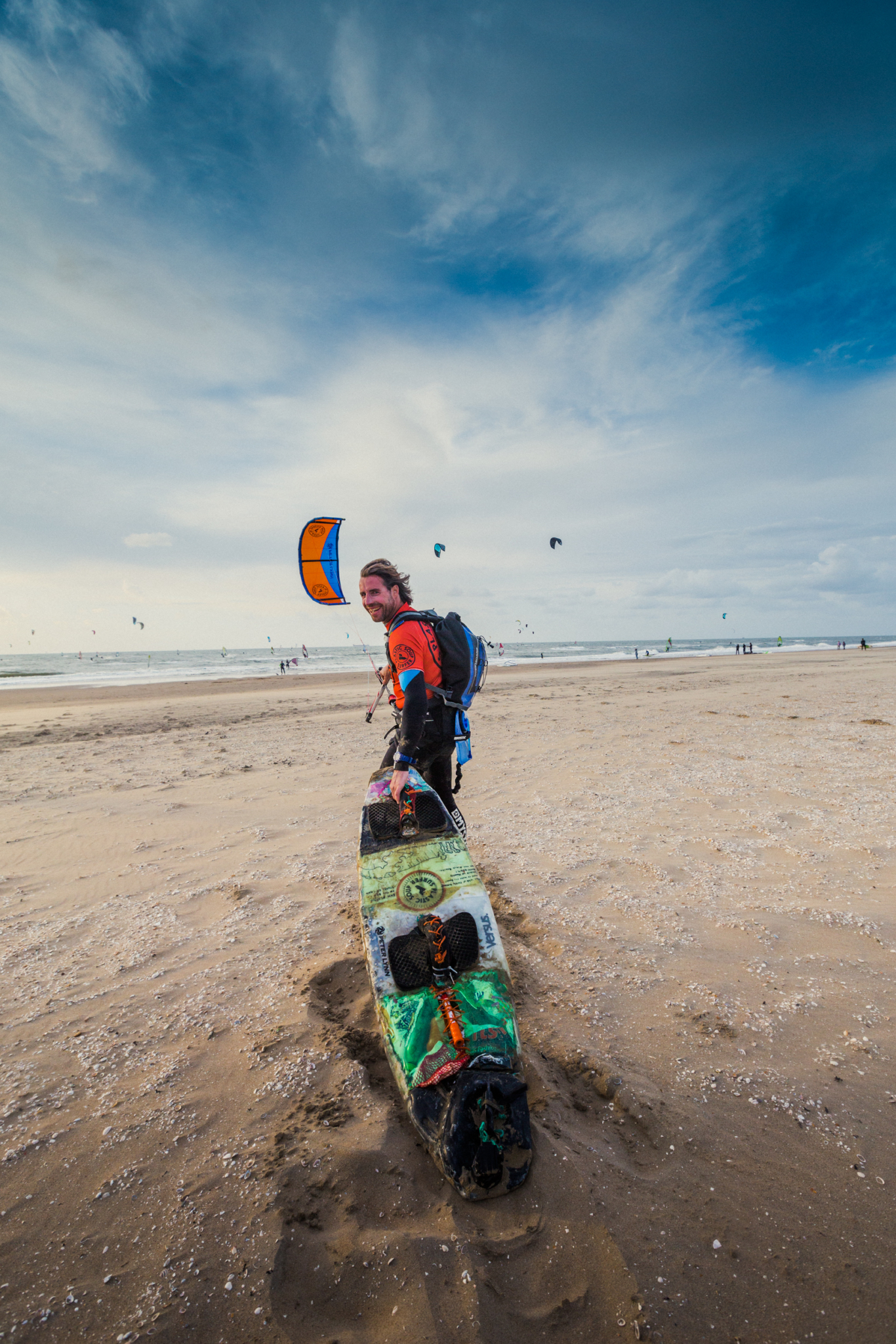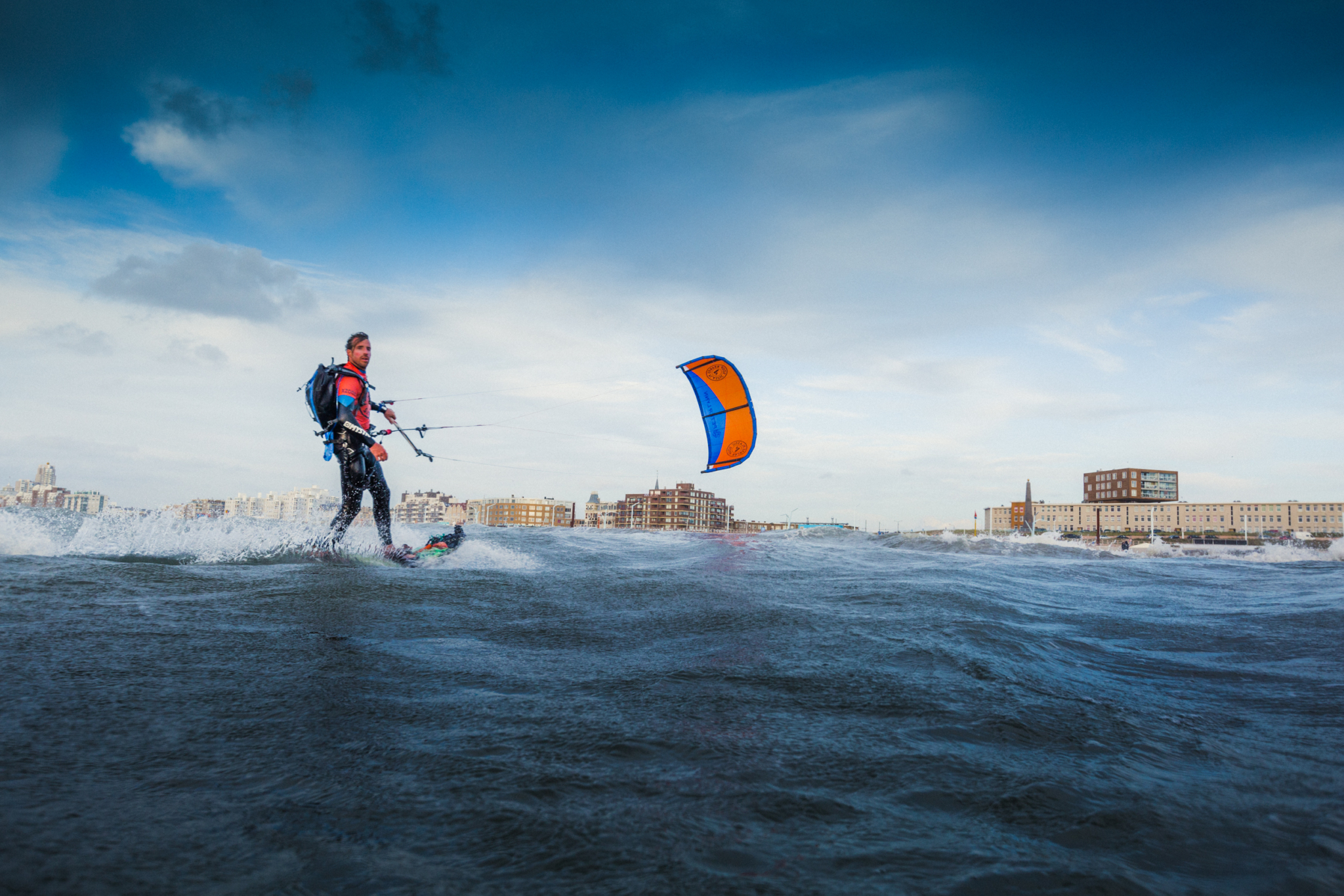Content type: Interview
Credits: Merijn Tinga (artist, Plastic Soup Surfer and Leiden University Alumnus). Interview by Alice Twemlow, transcription and editing by Lara Chapman.
Year: 2019
‘Art and design need to make abstract visions of environmental change as tangible as possible.’
Introduction:
In 2014 Merijn Tinga kite-surfed 350 kilometres along the Dutch and Belgian coast on a board made from plastic waste, and so became The Plastic Soup Surfer. Since then, Tinga, a former biologist turned artist and environmental activist, has devoted himself to initiating campaigns raising public, corporate and political awareness about plastic waste. In 2015, he collected floating plastic as he sailed the coast of Scandinavia. In 2016, he surfed from the Netherlands to England to petition a ban on plastic bottles. The following year, he paddled 1,200 kilometres down the Rhine over 28 days to draw attention to the impact of microplastics in the ocean. Tinga’s actions have not gone unnoticed. Perhaps his most significant victory to date was the response to Tinga’s 2016 petition by the Dutch Government, which is now working to introduce a deposit return scheme for small plastic bottles. Alice Twemlow caught up with the Plastic Soup Surfer to discuss how his work as a biologist, artist and environmental activism intersect.
Alice Twemlow: You studied and worked as a biologist and then, in 2014, changed paths to devote yourself to environmental activism through artistic practice. Does your scientific background influence your current work?
Merijn Tinga: I think that having a scientific background is important to properly understand and analyse the problem of plastic waste. I have studied the nature of polymers and the effect that they have on organisms. I have also read a lot of scientific research papers about the subject, concerning everything from the geographic areas of the oceans where plastic is found, to details about the effect of plastic on all marine life. I also have a good insight into how scientists communicate, which has been very important in getting more nuanced information to the public.
My previous life as a biologist also plays an important part in ‘the Plastic Soup Surfer’ story. Although I haven’t practised biology in years, my past experience means that people are able to take me as an authority on the issue.
AT: Why did you choose to focus on plastic waste in the marine environment?
MT: As an artist, I feel that it’s important to make work as close to myself and my own environment as possible. Every project is a search of myself: Why am I doing this? Why is this important to me? As a surfer, I was constantly confronted with plastic waste on the beach, which I knew was being washed out to sea where it could never be cleaned up. In the ocean, it becomes more hazardous as it breaks down into tiny pieces (called microplastics) that then disrupt the food chain. For example, there is a lot of evidence that photosynthesis in algae is reduced because of these microplastics.
I realised the power of the personal story when I surfed from Germany to Belgium on a board for the first time. Being an active part in the artwork gives it another dimension
AT: Tell me about the surfboards you create for your campaigns. What are some of the challenges involved in designing and building a surfboard from recycled plastic?
MT: The first surfboard I built (to surf from Belgium to Germany) was made from plastic waste that I found on the beach. I melted the polyethene using an iron rod and a gas burner and poured it into a custom-made mould. However, the board wasn’t strong enough to withstand the force of waves so I had to cover it with epoxy glassing which, of course, was not ideal.
I made the next board in collaboration with a board shaper using plastic bottles. Once again, there was no way around using the glass and epoxy coating, but the idea of an extraordinary-looking board that was clearly made from plastic bottles was a key part of the campaign.
The first two boards were very heavy and difficult to surf. They were fine for two or three days use, but not for my next project, which involved going down the entire Rhine. I worked with the University of Delft to find a way to make a stronger board from plastic bottles and they made a material from the bottles that could be 3D printed. The board looked great, but it was harder to see that it was made from plastic bottles. I liked that the other boards were rough and dirty, not too slick. They each had their own one-off feeling and were statements by themselves.
AT: What do you see as the next stage in this ongoing series of plastic surfboard projects?
MT: For my next project, I want to make a stand-up paddleboard from tyre wear (particles of rubber tyres that have worn away through use) swept up from the streets, preferably the Champs-Élysées in Paris. I imagine that sweeping just 100 metres of the street would be enough to make a stand-up paddleboard, or at least the coating for it. I will then paddle it down the Seine which, of course, starts at the Eiffel tower. The aim is to show everyone that all tyre wear in Paris pollutes the Seine and ends up in the English Channel. I can imagine the photograph already; me on the pitch-black paddleboard in front of the Eiffel Tower. It is usually the image of the action rather than the action itself that is the most important thing.

The Plastic Soup Surfer, Merijn Tinga, with his kitesurfing board made from plastic waste collected on the beach. Image Credit: Maurice Mikkers
AT: Could you expand on why the images are such an important part of your work?
MT: Images are the best form of communication and are a powerful way of drawing in media attention. I think of every project in three photographs. For my next project, I imagine the first photo will be of me sweeping the floor of the Champs-Élysées, in the second I will be standing in front of the Eiffel Tower with the board and the final one will be of me paddling onto the sand somewhere at the end of the journey. This will make up the whole story. It feels like an insta-story if I think about it now.
I think of every project in three photographs
AT: So you see the project as a form of storytelling?
MT: Yes. I realised the power of the personal story when I surfed from Germany to Belgium on a board for the first time. Being an active part in the artwork gives it another dimension. It makes it possible to have a much more personal, one-on-one connection with companies and CEOs. I think that telling my own story through an artwork is the best way for my message to have a real impact.
AT: What is your biggest success so far in terms of campaigning for legislation?
MT: Most objectively, it is of course the Dutch governmental legislation that mentions ‘Plastic Soup Surfer’ as the reason behind the move to require deposits for plastic bottles. For the rest, it’s hard to tell. Thousands of people have seen my film, it’s even been on the National Geographic channel, but it is hard to measure how much public awareness has increased.

The Plastic Soup Surfer, Merijn Tinga, kitesurfing in the Plastic Soup Image Credit: Maurice Mikkers
AT: Are you focused on a particular aspect of the campaign right now?
MT: Yes. I call it ‘The Plastic Transition’. It is a renewed vision on how we handle plastics at a societal level that is contrary to our current behaviour. I think we have passed the point of simply raising public awareness about the issues at hand. Instead, we need legislators and companies to reduce the amount of plastic used by society. We need to educate the consumer that recycling is not an answer to plastic pollution—which has always been the mantra of companies.
I’m looking for ways to achieve a paradigm shift. I am part of the ‘Plastic Avengers’, a group of activists who promote the idea that reducing plastic pollution needs to be a combined effort between legislators, companies and individuals. If we want real change we have to reassess the way that we handle plastic as a society. This is what our manifestois based upon.
AT: So your campaign is active at different levels, towards the industry for actual physical change and towards the public for awareness.
Designers and artists should be asking questions like: What does it look like to have a 100% responsible company?
AT: What do you think are some of the roles that design and art can play in responding to the environmental crisis?
MT: Art and design needs to make abstract visions of environmental change as tangible as possible. Designers and artists should be asking questions like: What does it look like to have a 100% responsible company? What does consumer responsibility really look like? Is it fair to expect consumer responsibility when companies do their utmost to subconsciously influence their customers to buy their products? How can convenience and low pricing stop being the top selling points of every product?
AT: So it can help us to reimagine a new value system. Having spent so much time on the issue of plastic pollution, do you feel optimistic about the potential for creating a change?
MT: I go through different phases. A few years ago I felt that I had the power to change things as a consumer, but the experience of being in this field for a long period of time and seeing how legislation or the enforcement of legislation works has made me feel increasingly powerless. Hearing companies repeat promises over and over but without taking any action makes it feel like taking three steps forwards and two steps back.
On a more positive note, experience has also taught me how to tell a story to achieve the greatest impact. For instance, the problem of tyre wear pollution has been around for years, and I’ve always questioned why I should address the issue when there is no real solution. However, I feel that telling the story through my actions is worthwhile, even if it is just to simply give the message that if we don’t jump in and take action, such as going down the Seine with a board made of tyres, nothing will change.